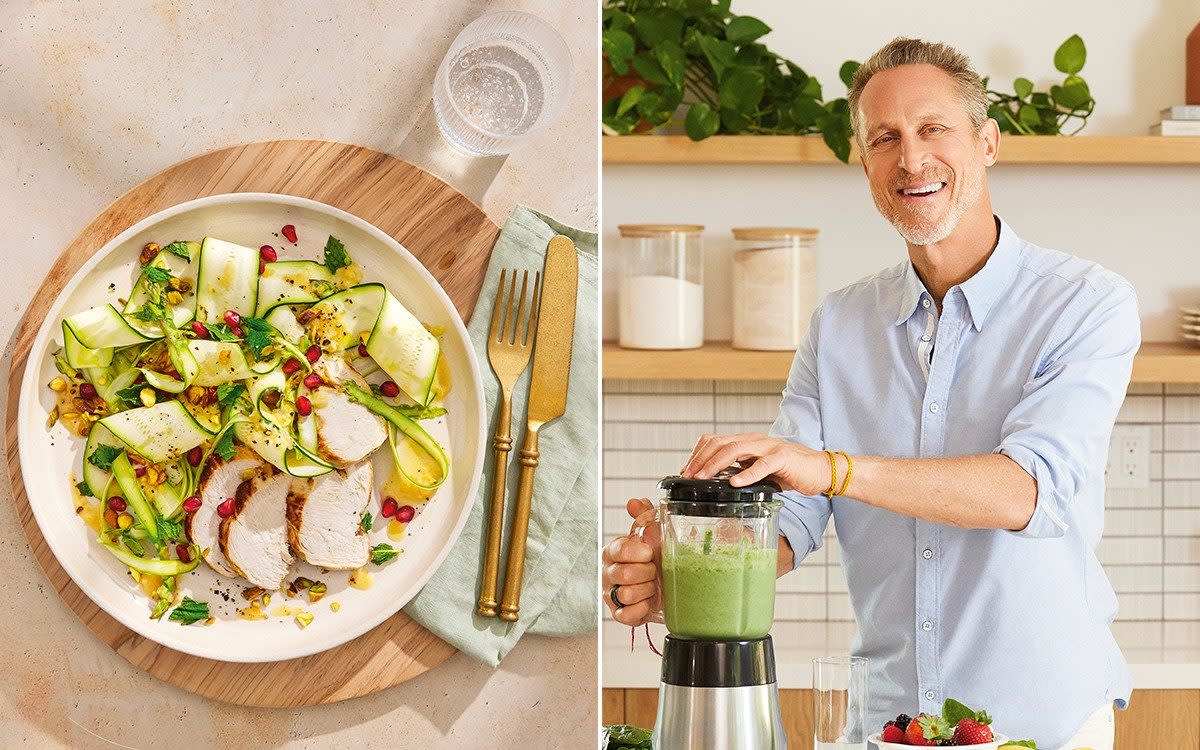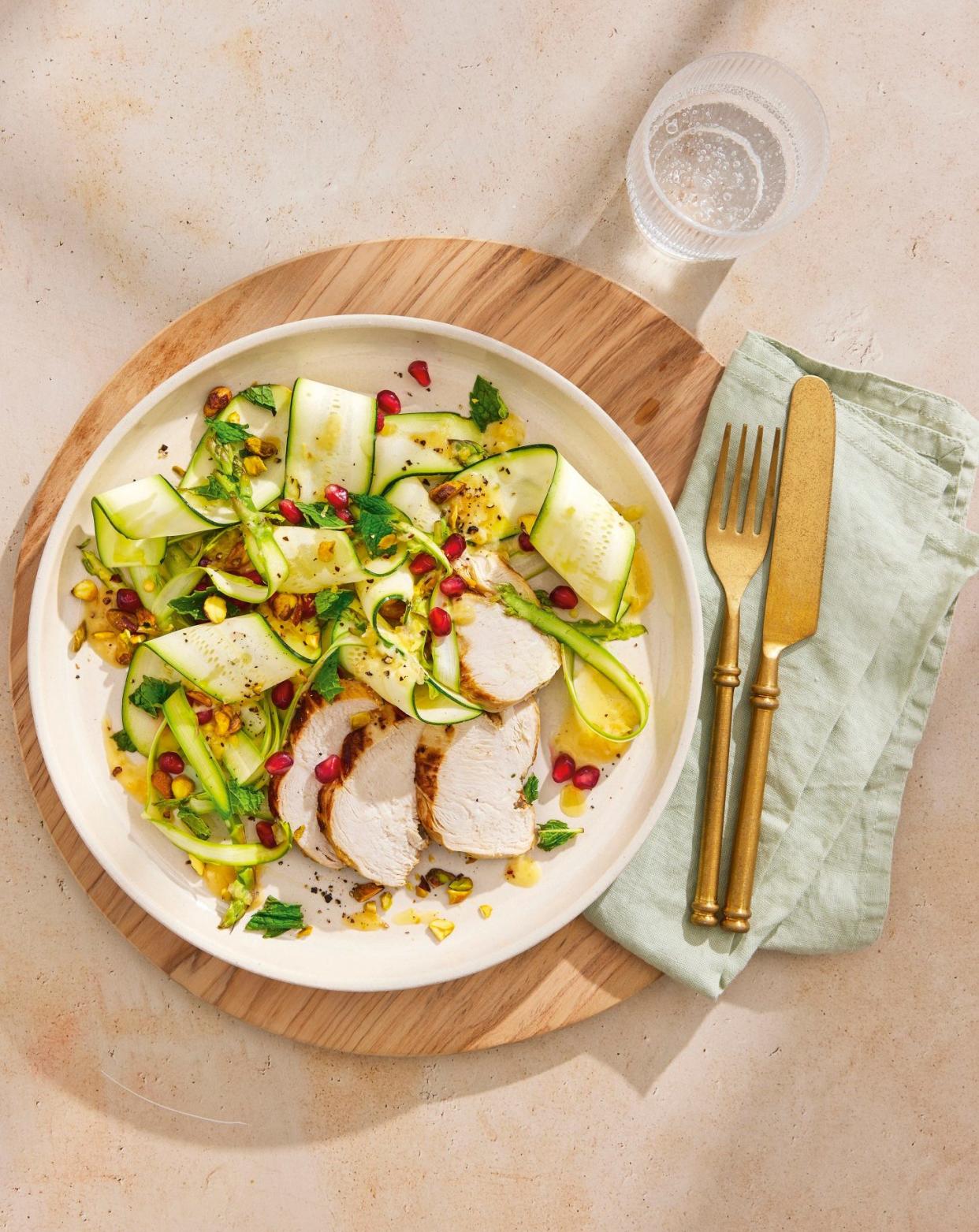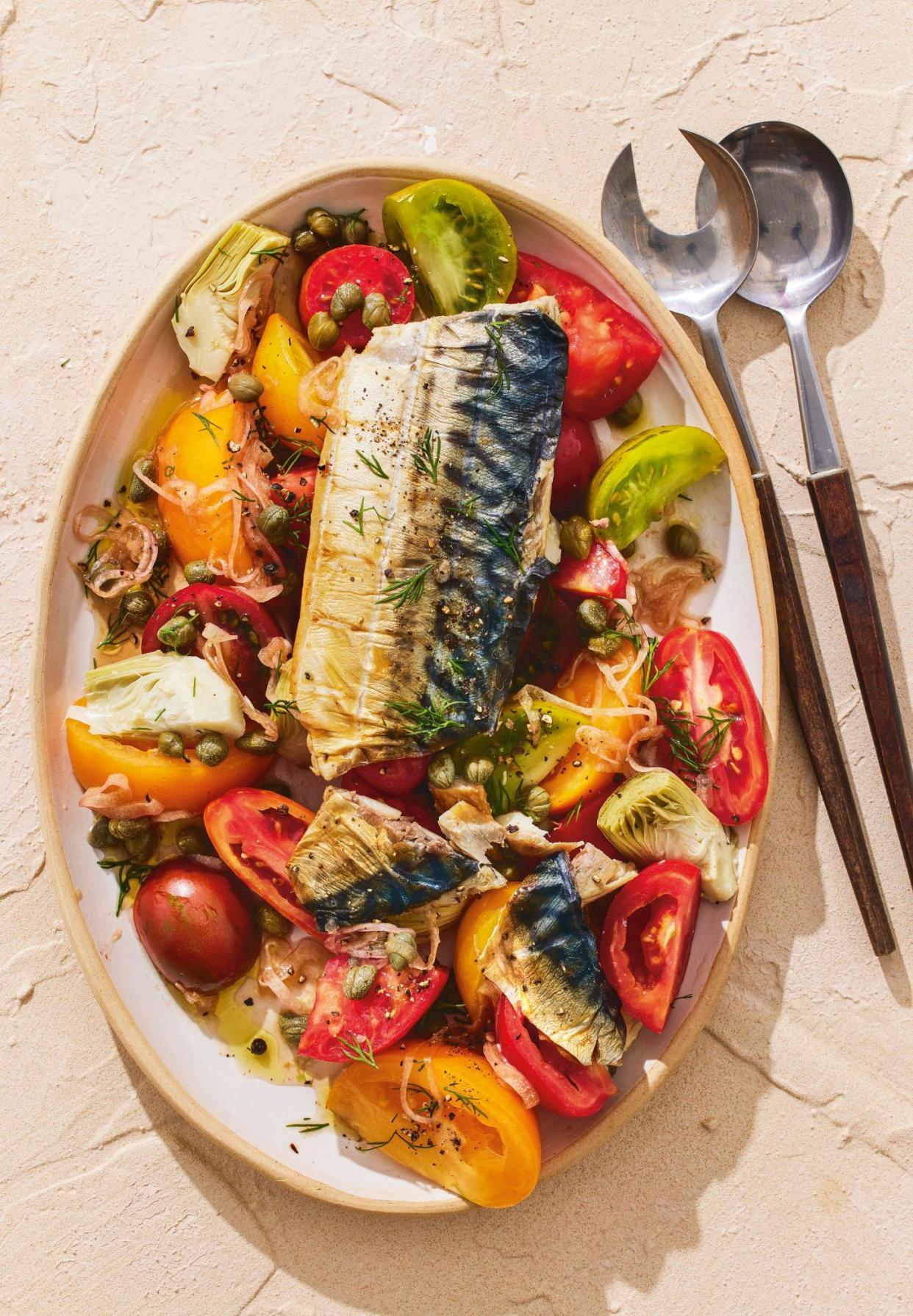16 small changes to make to your diet that will help you live longer

When you picture yourself in old age, you may assume you’ll be frail, have limited mobility and suffering from an illness, whether that’s dementia, heart disease or osteoporosis.
But the longevity guru Dr Mark Hyman, 64, who helped to popularise functional medicine (the idea that food should be the first line of therapy) and overhauled the Bill and Hillary Clintons’ diets, urges people to think again.
His advice is taken as gospel by his 3 million social media followers and the thousands he has helped to better health since the publication of his 2013 book The Daniel Plan, which interestingly was co-authored with Christian pastor Rick Warren, which encouraged readers to both lose weight and focus on their faith.
“Most of what we see as ageing is actually abnormal,” Dr Hyman says.
“The decline that happens is modifiable and we can reverse our biological age by how we eat, exercise and manage stress, even as we get chronologically older.
“Food is the most important lever we have to pull on this and people need to understand that what they eat is transforming everything about their health at every moment.”
The best-selling author and podcast host, whose latest book The Young Forever Cookbook promises youth-promoting recipes, here shares the principles behind eating for a longer and healthier life.
1. Cut out sugar and starch
The principles behind eating healthier to increase our health span (the number of years we live disease-free) as well as our lifespan are “not that complicated”, says Dr Hyman.
“It’s removing the things we know are harmful and adding in the foods that are protective. The things we know drive accelerated ageing are predominantly [refined] starch [a type of carbohydrate found in white bread, white rice and pastries] and sugar,” he says.
These ingredients fuel insulin resistance and inflammation throughout the body, he warns.
2. Avoid foods made in factories
“Ultra-processed food is generally made in factories with strange ingredients with names you can’t pronounce that have been linked to increased mortality,” he says.
For every 10 per cent of your diet that is ultra-processed, your risk of an early death increases by 14 per cent, according to a study published in JAMA Internal Medicine in 2019.
This is troubling, as around 60 per cent of our diet in the UK and US is ultra-processed, Dr Hyman notes.
“When you’re going to buy something to eat, ask yourself: ‘Did God make this or did man make this?’ It’s really pretty simple.”
3. Eat more anti-inflammatory fruit and vegetables
“We need large amounts of naturally-occurring phytochemicals. These have longevity benefits and are found in plant foods,” Dr Hyman says.
The compounds are found in fruit, vegetables, nuts, herbs and wholegrains.
“These regulate all the pathways that have to do with longevity, inflammation, oxidative stress [which can damage tissue and organs], mitochondrial function [which regulates energy], DNA repair and blood sugar. So these phytochemicals are not really optional.”
4. Eat one gramme of protein for every pound you weigh daily
As we age, our muscle mass declines by around three to five per cent per decade. It’s a natural part of the ageing process called sarcopenia.
To counteract this, Dr Hyman recommends upping your protein intake, matching your weight in pounds to protein intake in grams. For example, someone who weighs 120 lbs needs around 120g per day.
This is more than current UK recommendations of 0.75g of protein per kg per day. Under this method, a person who weighs 120 lbs would only eat 40g per day.
A skinless chicken breast (150g) contains around 36g of protein, while a medium egg contains 6g.
5. Choose grass-fed or free-range meat
When it comes to eating meat, choose grass-fed or free-range, he says.
Plant proteins are also a good option but choose non-genetically modified tofu and tempeh (a meat alternative made from fermented soybeans) as these contain a higher concentration of protein and less calories and starch, according to Dr Hyman.
6. Make a savoury breakfast
“Fish and eggs are great for breakfast,” says Dr Hyman.
It is a protein-rich option that avoids starting the day with sugary breakfast cereals, pastries or yoghurt, and helps build muscle, he says.
“If you want yoghurt for breakfast instead, I recommend sheep or goat’s yoghurt. Add things that increase protein content, for example walnuts, almonds and pumpkin seeds.”
The average person should aim to consume 30g of protein with breakfast, he says.
Protein shakes can help with this, especially as people get older and their protein requirements increase, as shakes are easily absorbed and used to build muscle, he says.
“I like goat whey protein powder because it’s more pasteurised and regenerative than cow, so it’s what I recommend,” he adds.
7. Never eat “naked carbs”
This term refers to eating carbohydrates, such as white bread, white rice and fruit, without having fibre, protein or fat alongside them.
“If you’re eating berries and have them with yoghurt and nuts, you’re reducing this spike in blood sugar,” Dr Hyman says. Or you can mix fruit with protein shakes.
8. Don’t snack
“I don’t really think that most people should be snacking. I think it’s a modern invention,” Dr Hyman says.
“If people eat the right food, they’re not hungry, their appetite is regulated well and they don’t have to snack. When you eat a lot of starch and sugar, you end up having pretty significant cravings and hunger.”
People who start their day with a muffin or bagel are left with hunger pangs, struggle to manage their appetite and feel like they need to snack, he says.
“But if you’re doing the right thing with your diet, you really won’t need to snack,” he adds.
If you want the occasional biscuit or chocolate bar, eat it alongside protein and fat to prevent dramatic blood sugar spikes, he recommends.
9. Fast for at least 12 hours overnight
“Everybody should be doing at least a 12 hour overnight fast,” he says.
This would mean eating, for example, eating dinner at 7pm and then not eating again until after 7am the next morning. Studies suggest that this approach can help with weight loss, boost gut health, reduce inflammation and improve blood sugar.
10. Don’t drink liquid calories
When it comes to liquids, stick to water, coffee and tea, Dr Hyman recommends.
“One of the main things that harms us is rapidly-absorbed liquid sugar calories, from juice or from sodas or energy drinks,” he says. “It really is the biggest driver of insulin resistance and prediabetes.”
Insulin resistance occurs when insulin (a hormone released by the pancreas to bring down blood sugar levels) isn’t working properly, so the organ releases increasing amounts of insulin. This can eventually tire the pancreas out. It can lead to prediabetes, which is when a person’s blood sugar is too high and they’re at risk of developing type 2 diabetes.
11. Avoid alcohol – even red wine
Some studies have suggested that, in moderation, wine may benefit our health.
“The more data we’ve gotten, it’s become clear that this isn’t true and that there’s really no safe limit of alcohol – it’s a recreational drug,” Dr Hyman says.
“That doesn’t mean you can’t have it occasionally but it shouldn’t be a staple, as it increases our risk of cancer. People should be conscious that it’s not a health food.”
12. Eat cruciferous vegetables every day
“Everyday, I try to eat at least a couple of cups of cruciferous vegetables – broccoli, collard greens, kale, brussel sprouts,” Dr Hyman says.
Studies have linked these foods to a healthier heart, cholesterol levels and blood sugar control.
13. Eat more seeds and sardines
“A lot of evidence shows that nuts and seeds (especially flax and chia) help with conditions such as heart disease and cancer, so they are a key part of the longevity diet,” he says.
Food rich in omega-3 fatty acids, such as small fish like sardines, mackerel, herring and anchovies, also have protective effects, he says. Some omega-3s are thought to reduce a type of fat in the blood called triglycerides, improve circulation and prevent blood clots.
14. Choose your oils wisely
“I mostly have extra virgin olive oil but, for high-temperature cooking, I use avocado oil,” Dr Hyman says. Studies suggest that extra virgin olive oil protects the heart and brain, while studies in animals suggest that avocado oil reduces cholesterol levels.
“I also sometimes have ghee, which can be very good for high-temperature cooking, and grass-fed butter.”
15. Avoid starting your meal with bread and alcohol
“Bread and alcohol at the beginning [of a meal] is the worst thing you can do,” Dr Hyman says.
This combination spikes our blood sugar levels and “the single thing we know is that insulin resistance is the biggest driver of ageing,” he adds.
16. Stick to protein and vegetables when dining out
It can be challenging to eat healthily at restaurants, so a good rule of thumb is to stick to ordering protein and two to three servings of vegetables, Dr Hyman says.
“Eat your fibre and protein first and add any starch towards the end of the meal,” he adds.
Recipes from The Young Forever Cookbook by Dr Mark Hyman
Published by Yellow Kite, £20
Jump to:
Courgette ribbons with grilled chicken and preserved lemon

Beautiful summer courgettes are a delicious type of low-carb squash that can be prepared in many ways, including simply peeled into ribbons and served raw.
Courgettes are packed with nutrients, such as vitamin C and magnesium, and also contain carotenoids, which are proven to help reduce your risk of cardiovascular disease. Here I’ve paired courgettes and asparagus ribbons with tender lemony chicken for a protein and flavour boost.
Remember the following key points when making this salad: choose small courgettes, as they contain fewer seeds and less water; gently use a vegetable peeler to shave them into long ribbons; and wait to dress the salad until just before you’re ready to serve it.
Serves
4
Prep time
20 minutes
Cook time
15 minutes
Ingredients
For the dressing
2 tablespoons extra-virgin olive oil
2 tablespoons lemon juice
2 tablespoons preserved lemon, seeded, then skin and flesh finely chopped
1 tablespoon tahini
1 garlic clove, grated
1 teaspoon honey
½ teaspoon sea salt
Pinch of freshly ground black pepper
For the chicken
450 g boneless, skinless, free range chicken breasts
1 garlic clove, roughly chopped
2 tablespoons lemon juice
2 tablespoons extra-virgin olive oil
½ teaspoon sea salt
½ teaspoon freshly ground black pepper
For the salad
2 small courgettes, shaved into ribbons
225 g asparagus, woody ends trimmed and stalks shaved into ribbons
90 g pomegranate seeds
1 tablespoon chopped fresh mint leaves
30 g toasted pistachios, roughly chopped
Method
1. For the dressing: In a small bowl, whisk all the ingredients together until smooth. Set aside.
2. For the chicken: Preheat the grill or a griddle pan using a medium/high heat. Using a sharp knife, slice the chicken breasts in half horizontally, starting with the more bulbous end. Place the chicken in a non-reactive bowl and add the garlic, lemon juice, olive oil, salt and pepper. Set aside while you prepare the salad.
3. For the salad: Place the courgette and asparagus shavings in a bowl lined with kitchen paper for about 10 minutes; this helps to draw out any excess moisture. Arrange the shavings on a large platter. Sprinkle with the pomegranate seeds, mint leaves and pistachios.
4. Grill the chicken for 5 to 7 minutes per side, until cooked through, or until the internal temperature reaches 74°C. Set aside to cool slightly, then thinly slice.
5. To serve: Drizzle the salad with the dressing and serve with the lemony grilled chicken.
Smoky Turkish beef kebabs

These kebabs are great for summertime grilling as rump is a lean cut that cooks quickly while remaining tender. The skewers are paired with a bright onion salad seasoned with sumac, a tangy and slightly acidic spice made from ground berries. Marinate the kebabs overnight for even more flavour, then serve alongside my Spiced Kohlrabi with Pomegranate and
Feta (page 154) for a complete meal. You’ll need to soak ten bamboo skewers in water for at least 30 minutes before threading the beef and spring onions onto them.
Serves
4 to 6
Prep time
30 minutes
Cook time
10 minutes
Ingredients
For the kebabs
2 tablespoons extra-virgin olive oil
2 tablespoons grated onion
1 tablespoon tomato purée
4 garlic cloves, grated
1 tablespoon smoked paprika
1 teaspoon ground cumin
1 teaspoon sea salt
½ teaspoon cayenne pepper
½ teaspoon freshly ground black pepper
1.25 kg grass-fed beef rump, cut into 2.5-cm cubes
1 large bunch spring onions, cut into 7.5-cm pieces
Avocado oil, for grilling
For the onion salad
1 red onion, thinly sliced
1 tablespoon extra-virgin olive oil
2 tablespoons lemon juice
2 teaspoons ground sumac
1 teaspoon sea salt
2 tablespoons finely chopped fresh mint
Method
1. For the kebabs: In a large bowl, combine the olive oil, onion, tomato purée, garlic, paprika, cumin, salt, cayenne and black pepper. Add the beef cubes, tossing to coat. Marinate at room temperature for at least 20 minutes, or refrigerate overnight.
2. Thread three or four cubes of meat onto the skewers, alternating them with the spring onion pieces.
3. For the onion salad: Combine the onion, olive oil, lemon juice, sumac and salt in a small bowl. Use your hands to gently massage the dressing into the onions, mixing everything well, then stir in the mint.
4. Preheat the grill or a griddle pan until hot. Lightly brush the grill rack or pan with the avocado oil, then add the kebabs and cook for 4 to 5 minutes per side, until the beef is cooked through and the spring onions are charred. Serve with the onion salad on the side.
Summer tomato salad with smoked mackerel

This super-simple yet satisfying salad is a great example of balanced flavours. Smoky fish pairs perfectly with sweet tomatoes and bright shallots.
Smoked mackerel is a flavourful, ready-to-serve protein that is packed with vitamins B₁₂ and D, along with iodine, which can help regulate thyroid hormones. Its rich flavour and high antioxidant properties can also add variety to your diet. I love to serve the salad in the late summer months when heirloom tomatoes are at their peak, but you can just use the best variety of tomatoes you can find.
Serves
4
Prep time
10 minutes
Ingredients
1 shallot, thinly sliced
2 tablespoons sherry vinegar
2 tablespoons extra-virgin olive oil
½ teaspoon sea salt
750 g mixed heirloom and cherry tomatoes, cut into pieces or halved
1 × 400-g can artichoke hearts, drained and quartered
2 tablespoons capers, drained
1 tablespoon chopped fresh dill, plus more for garnish
175 g smoked mackerel fillet
2 tablespoons toasted pine nuts
Freshly ground black pepper, for serving
Method
1. In a small bowl, combine the shallot and sherry vinegar and let sit for 10 minutes. Whisk in the olive oil and season with salt to taste.
2. In a large bowl, toss the tomatoes with the artichokes, capers and dill. Remove the shallots from the vinaigrette and add them to the salad, tossing to coat. Top with the fillets of mackerel. Drizzle with the reserved vinaigrette and garnish with toasted pine nuts, a twist of ground black pepper and additional dill.
Tip: Make sure you keep your tomatoes at room temperature. This ensures the best texture because tomatoes contain an enzyme that reacts with the cold, giving them a mushy and mealy texture.


